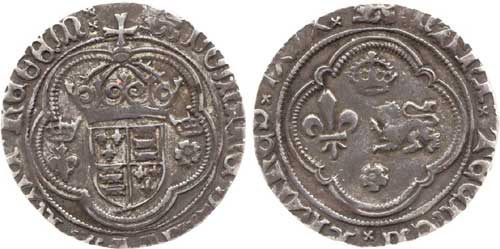
Auction: 4002 - The Marshall Collection of British & World Coins
Lot: 86
Perkin Warbeck (pretender to the English throne, executed 1499), Medallic Jeton or Groat, 3.91g., 60.3 grains, 1494, m.m. lion, crowned arms with crowned lis and rose at sides, within tressure, domine salvvm fac regem, rev., crown above lis and lion, rose below, within tressure, mani teckel phares 1494, double saltire stops (N.1758; MI.21/3), struck on a small flan (as usual), an excellent example, good very fine, extremely rare Estimate £ 1,500-2,000 provenance:
T Hollis, Sotheby, 14 May 1817, lot 302
H R Willett, collection of Patterns purchased privately by J D Cuff
J D Cuff, Sotheby, 8 June 1854, lot 958
E W Rashleigh, Sotheby, 21 June 1909, lot 774
B Roth, Sotheby, 19 July 1917, lot 243
L E Bruun, Sotheby, 18 May 1925, lot 546
T B Clarke Thornhill, Glendining, 24 May 1937, lot 429
Spink Numismatic Circular, July 1942, no.15405 £40-0-0
Perkin Warbeck, claiming to be Richard, Duke of York, the brother of Edward V, tried to invade England three times. He was finally captured near London and was executed in 1499.
These extremely rare pieces, of which around fifteen examples are known, are believed to emanate from the Burgundian Low Countries. They carry the royal arms of England and, although anonymous, have generally been accepted as being associated with Warbeck. The date, 1494, the legend, on one side a version of the writing on the wall at Belshazzar's feast (seemingly a threat to Henry VII) and on the other the Latin equivalent of 'O God, save the King' (a reference to the pretender) and the general resemblance of the obverse to a description of a seal of Warbeck's strengthen the attribution.
The average weight of the extant examples is around 60 grains, in contrast to the 48 grain standard for the contemporary English groat, and the existence of only one pair of dies suggest that they were not a serious exercise in finance, but they may well have been struck in the run up to Warbeck's 'invasion' of England in July 1495.
Curiously the specimen in the Fitzwilliam Museum was bequeathed to Cambridge University as long ago as 1589 (C E Blunt, BNJ 1950 pp.215-6)
Sold for
£4,200




